Mobile On-Road Measurements of Aerosol Optical Properties during MOABAI Campaign in the North China Plain
Abstract
:1. Introduction
2. Materials and Methods
2.1. MOABAI Campaign
2.2. Mobile Laboratory
2.2.1. Micro-Pulse LIDAR
2.2.2. Mobile Sun Photometer
2.2.3. In Situ Optical Instruments
2.2.4. Weather Station
2.3. Methods for Retrieving Aerosol Properties
2.3.1. Extinction Profiles
2.3.2. Columnar Volume Size Distribution
2.3.3. Mass Concentration Profiles
3. Experimental Results
3.1. Overview of Aerosol Properties during MOABAI Campaign
3.2. Case Study: Tianjin Coastal Area, 17 May 2017
3.2.1. Study Area and Meteorological Conditions
3.2.2. Particle Size Distribution at Surface Level
3.2.3. Aerosol Scattering and Absorption at Surface Level
3.2.4. Columnar Volume Size Distribution
3.2.5. Extinction Coefficient Profiles
3.2.6. Mass Concentration Profiles
4. Summary and Applications
4.1. Summary
4.2. Applications
Supplementary Materials
Author Contributions
Funding
Institutional Review Board Statement
Informed Consent Statement
Data Availability Statement
Acknowledgments
Conflicts of Interest
References
- Chen, H.; Wang, H. Haze days in North China and the associated atmospheric circulations based on daily visibility data from 1960 to 2012. J. Geophys. Res. Atmos. 2015, 120, 5895–5909. [Google Scholar] [CrossRef]
- Yang, Y.; Wang, H.; Smith, S.J.; Zhang, R.; Lou, S.; Qian, Y.; Ma, P.-L.; Rasch, P.J. Recent intensification of winter haze in China linked to foreign emissions and meteorology. Sci. Rep. 2018, 8, 2107. [Google Scholar] [CrossRef] [PubMed] [Green Version]
- Han, L.; Zhou, W.; Li, W. Increasing impact of urban fine particles (PM2.5) on areas surrounding Chinese cities. Sci. Rep. 2015, 5, 12467. [Google Scholar] [CrossRef] [PubMed] [Green Version]
- An, Z.; Huang, R.-J.; Zhang, R.; Tie, X.; Li, G.; Cao, J.; Zhou, W.; Shi, Z.; Han, Y.; Gu, Z.; et al. Severe haze in northern China: A synergy of anthropogenic emissions and atmospheric processes. Proc. Natl. Acad. Sci. USA 2019, 116, 8657–8666. [Google Scholar] [CrossRef] [PubMed] [Green Version]
- Sun, L.; Li, R.; Tian, X.-P.; Wei, J. Analysis of the temporal and spatial variation of Aerosols in the Beijing-Tianjin-Hebei region with a 1 km AOD product. Aerosol Air Qual. Res. 2017, 17, 923–935. [Google Scholar] [CrossRef] [Green Version]
- Zhu, Y.; Zhang, J.; Wang, J.; Chen, W.; Han, Y.; Ye, C.; Li, Y.; Liu, J.; Zeng, L.; Wu, Y.; et al. Distribution and sources of air pollutants in the North China Plain based on on-road mobile measurements. Atmos. Chem. Phys. Discuss. 2016, 16, 12551–12565. [Google Scholar] [CrossRef] [Green Version]
- Lei, Y.; Zhang, Q.; He, K.B.; Streets, D.G. Primary anthropogenic aerosol emission trends for China, 1990–2005. Atmos. Chem. Phys. Discuss. 2011, 11, 931–954. [Google Scholar] [CrossRef] [Green Version]
- Yu, X.; Lü, R.; Liu, C.; Yuan, L.; Shao, Y.; Zhu, B.; Lei, L. Seasonal variation of columnar aerosol optical properties and radiative forcing over Beijing, China. Atmos. Environ. 2017, 166, 340–350. [Google Scholar] [CrossRef]
- Li, J. Pollution trends in China from 2000 to 2017: A multi-sensor view from space. Remote. Sens. 2020, 12, 208. [Google Scholar] [CrossRef] [Green Version]
- Sun, J.; Zhang, M.; Liu, T. Spatial and temporal characteristics of dust storms in China and its surrounding regions, 1960–1999: Relations to source area and climate. J. Geophys. Res. Atmos. 2001, 106, 10325–10333. [Google Scholar] [CrossRef]
- Ma, Z.; Liu, R.; Liu, Y.; Bi, J. Effects of air pollution control policies on PM2.5 pollution improvement in China from 2005 to 2017: A satellite-based perspective. Atmos. Chem. Phys. Discuss. 2019, 19, 6861–6877. [Google Scholar] [CrossRef] [Green Version]
- Zhai, S.; Jacob, D.J.; Wang, X.; Shen, L.; Li, K.; Zhang, Y.; Gui, K.; Zhao, T.; Liao, H. Fine particulate matter (PM2.5) trends in China, 2013–2018: Contributions from meteorology. Atmos. Chem. Phys. Discuss. 2019, 19, 11031–11041. [Google Scholar] [CrossRef] [Green Version]
- Popovici, I.E.; Goloub, P.; Podvin, T.; Blarel, L.; Loisil, R.; Unga, F.; Mortier, A.; Deroo, C.; Victori, S.; Ducos, F.; et al. Description and applications of a mobile system performing on-road aerosol remote sensing and in situ measurements. Atmos. Meas. Tech. 2018, 11, 4671–4691. [Google Scholar] [CrossRef] [Green Version]
- Freudenthaler, V.; Linné, H.; Chaikovski, A.; Rabus, D.; Groß, S. EARLINET LiDAR quality assurance tools. Atmos. Meas. Tech. Discuss. 2018, 2018, 1–35. [Google Scholar] [CrossRef] [Green Version]
- Müller, T.; Laborde, M.; Kassell, G.; Wiedensohler, A. Design and performance of a three-wavelength LED-based total scatter and backscatter integrating nephelometer. Atmos. Meas. Tech. 2011, 4, 1291–1303. [Google Scholar] [CrossRef] [Green Version]
- Drinovec, L.; Močnik, G.; Zotter, P.; Prévôt, A.S.H.; Ruckstuhl, C.; Coz, E.; Rupakheti, M.; Sciare, J.; Müller, T.; Wiedensohler, A.; et al. The “dual-spot” Aethalometer: An improved measurement of aerosol black carbon with real-time loading compensation. Atmos. Meas. Tech. 2015, 8, 1965–1979. [Google Scholar] [CrossRef] [Green Version]
- Fernald, F.G. Analysis of atmospheric lidar observations: Some comments. Appl. Opt. 1984, 23, 652–653. [Google Scholar] [CrossRef]
- Klett, J.D. Stable analytical inversion solution for processing lidar returns. Appl. Opt. 1981, 20, 211–220. [Google Scholar] [CrossRef] [PubMed] [Green Version]
- Mortier, A. Tendances et Variabilites de L’aerosol Atmospherique a L’aide du Couplage Lidar/Photometre sur les Sites de Lille et Dakar. Ph.D. Thesis, University of Lille, Lille, France, 2013. [Google Scholar]
- Mortier, A.; Goloub, P.; Podvin, T.; Deroo, C.; Chaikovsky, A.; Ajtai, N.; Blarel, L.; Tanre, D.; Derimian, Y. Detection and characterization of volcanic ash plumes over Lille during the Eyjafjallajökull eruption. Atmos. Chem. Phys. Discuss. 2013, 13, 3705–3720. [Google Scholar] [CrossRef] [Green Version]
- Mortier, A.; Goloub, P.; Derimian, Y.; Tanré, D.; Podvin, T.; Blarel, L.; Deroo, C.; Marticorena, B.; Diallo, A.; Ndiaye, T. Climatology of aerosol properties and clear-sky shortwave radiative effects using Lidar and Sun photometer observations in the Dakar site. J. Geophys. Res. Atmos. 2016, 121, 6489–6510. [Google Scholar] [CrossRef]
- Popovici, I.E. Aerosol Spatial and Temporal Variability as Seen by Mobile Aerosol Monitoring System (MAMS). 2018. Available online: http://www.theses.fr (accessed on 23 December 2021).
- Randriamiarisoa, H.; Chazette, P.; Couvert, P.; Sanak, J.; Mégie, G. Relative humidity impact on aerosol parameters in a Paris suburban area. Atmos. Chem. Phys. Discuss. 2006, 6, 1389–1407. [Google Scholar] [CrossRef] [Green Version]
- Skupin, A.; Ansmann, A.; Engelmann, R.; Seifert, P.; Müller, T. Four-year long-path monitoring of ambient aerosol extinction at a central European urban site: Dependence on relative humidity. Atmos. Chem. Phys. Discuss. 2016, 16, 1863–1876. [Google Scholar] [CrossRef] [Green Version]
- Pan, X.L.; Yan, P.; Tang, J.; Ma, J.Z.; Wang, Z.F.; Gbaguidi, A.; Sun, Y.L. Observational study of influence of aerosol hygroscopic growth on scattering coefficient over rural area near Beijing mega-city. Atmos. Chem. Phys. Discuss. 2009, 9, 7519–7530. [Google Scholar] [CrossRef] [Green Version]
- Dubovik, O.; Herman, M.; Holdak, A.; Lapyonok, T.; Tanré, D.; Deuzé, J.L.; Ducos, F.; Sinyuk, A.; Lopatin, A. Statistically optimized inversion algorithm for enhanced retrieval of aerosol properties from spectral multi-angle polarimetric satellite observations. Atmos. Meas. Tech. 2011, 4, 975–1018. [Google Scholar] [CrossRef] [Green Version]
- Dubovik, O.; Lapyonok, T.; Litvinov, P.; Herman, M.; Fuertes, D.; Ducos, F.; Torres, B.; Derimian, Y.; Huang, X.; Lopatin, A.; et al. GRASP: A versatile algorithm for characterizing the atmosphere. SPIE Newsroom 2014, 2–5. [Google Scholar] [CrossRef]
- Dubovik, O.; Li, Z.; Mishchenko, M.I.; Tanré, D.; Karol, Y.; Bojkov, B.; Cairns, B.; Diner, D.J.; Espinosa, W.R.; Goloub, P.; et al. Polarimetric remote sensing of atmospheric aerosols: Instruments, methodologies, results, and perspectives. J. Quant. Spectrosc. Radiat. Transf. 2019, 224, 474–511. [Google Scholar] [CrossRef]
- Torres, B.; Dubovik, O.; Fuertes, D.; Schuster, G.; Cachorro, V.E.; Lapyonok, T.; Goloub, P.; Blarel, L.; Barreto, A.; Mallet, M.; et al. Advanced characterisation of aerosol size properties from measurements of spectral optical depth using the GRASP algorithm. Atmos. Meas. Tech. 2017, 10, 3743–3781. [Google Scholar] [CrossRef] [Green Version]
- Torres, B.; Fuertes, D. Characterization of aerosol size properties from measurements of spectral optical depth: A global validation of the GRASP-AOD code using long-term AERONET data. Atmos. Meas. Tech. 2021, 14, 4471–4506. [Google Scholar] [CrossRef]
- Lagrosas, N.; Kuze, H.; Takeuchi, N.; Fukagawa, S.; Bagtasa, G.; Yoshii, Y.; Naito, S.; Yabuki, M. Correlation study between suspended particulate matter and portable automated lidar data. J. Aerosol Sci. 2005, 36, 439–454. [Google Scholar] [CrossRef]
- Lewandowski, P.A.; Eichinger, W.E.; Holder, H.; Prueger, J.; Wang, J.; Kleinman, L.I. Vertical distribution of aerosols in the vicinity of Mexico City during MILAGRO-2006 Campaign. Atmos. Chem. Phys. Discuss. 2010, 10, 1017–1030. [Google Scholar] [CrossRef] [Green Version]
- Stein, A.F.; Draxler, R.R.; Rolph, G.D.; Stunder, B.J.B.; Cohen, M.D.; Ngan, F. NOAA’s HYSPLIT atmospheric transport and dispersion modeling system. Bull. Am. Meteorol. Soc. 2015, 96, 2059–2077. [Google Scholar] [CrossRef]
- Li, W.; Wang, W.; Zhou, Y.; Ma, Y.; Zhang, D.; Sheng, L. Occurrence and reverse transport of severe dust storms associated with synoptic weather in East Asia. Atmosphere 2018, 10, 4. [Google Scholar] [CrossRef] [Green Version]
- Kong, S.; Han, B.; Bai, Z.; Chen, L.; Shi, J.; Xu, Z. Receptor modeling of PM2.5, PM10 and TSP in different seasons and long-range transport analysis at a coastal site of Tianjin, China. Sci. Total. Environ. 2010, 408, 4681–4694. [Google Scholar] [CrossRef]
- Su, X.; Wang, Q.; Li, Z.; Calvello, M.; Esposito, F.; Pavese, G.; Lin, M.; Cao, J.; Zhou, C.; Li, N.; et al. Regional transport of anthropogenic pollution and dust aerosols in spring to Tianjin—A coastal megacity in China. Sci. Total. Environ. 2017, 584–585, 381–392. [Google Scholar] [CrossRef]
- Ni, T.; Li, P.; Han, B.; Bai, Z.; Ding, X.; Wang, Q.; Huo, J.; Lu, B. Spatial and temporal variation of chemical composition and mass closure of ambient PM10 in Tianjin, China. Aerosol Air Qual. Res. 2013, 13, 1832–1846. [Google Scholar] [CrossRef] [Green Version]
- Lyu, L.; Dong, Y.; Zhang, T.; Liu, C.; Liu, W.; Xie, Z.; Xiang, Y.; Zhang, Y.; Chen, Z.; Fan, G.; et al. Vertical distribution characteristics of PM2.5 observed by a mobile vehicle lidar in Tianjin, China in 2016. J. Meteorol. Res. 2018, 32, 60–68. [Google Scholar] [CrossRef]
- Hildemann, L.M.; Markowski, G.R.; Jones, M.C.; Cass, G.R. Submicrometer Aerosol mass distributions of emissions from boilers, fireplaces, automobiles, diesel trucks, and meat-cooking operations. Aerosol Sci. Technol. 1991, 14, 138–152. [Google Scholar] [CrossRef]
- Merico, E.; Donateo, A.; Gambaro, A.; Cesari, D.; Gregoris, E.; Barbaro, E.; Dinoi, A.; Giovanelli, G.; Masieri, S.; Contini, D. Influence of in-port ships emissions to gaseous atmospheric pollutants and to particulate matter of different sizes in a Mediterranean harbour in Italy. Atmos. Environ. 2016, 139, 1–10. [Google Scholar] [CrossRef]
- Petzold, A.; Hasselbach, J.; Lauer, P.; Baumann, R.; Franke, K.; Gurk, C.; Schlager, H.; Weingartner, E. Experimental studies on particle emissions from cruising ship, their characteristic properties, transformation and atmospheric lifetime in the marine boundary layer. Atmos. Chem. Phys. Discuss. 2008, 8, 2387–2403. [Google Scholar] [CrossRef] [Green Version]
- Popovicheva, O.; Kireeva, E.; Shonija, N.; Zubareva, N.; Persiantseva, N.; Tishkova, V.; Demirdjian, B.; Moldanová, J.; Mogilnikov, V. Ship particulate pollutants: Characterization in terms of environmental implication. J. Environ. Monit. 2009, 11, 2077–2086. [Google Scholar] [CrossRef] [PubMed]
- Randles, C. Hygroscopic and optical properties of organic sea salt aerosol and consequences for climate forcing. Geophys. Res. Lett. 2004, 31, 4–7. [Google Scholar] [CrossRef]
- Liu, X.; Cheng, Y.; Zhang, Y.; Jung, J.; Sugimoto, N.; Chang, S.-Y.; Kim, Y.J.; Fan, S.; Zeng, L. Influences of relative humidity and particle chemical composition on aerosol scattering properties during the 2006 PRD campaign. Atmos. Environ. 2008, 42, 1525–1536. [Google Scholar] [CrossRef]
- Han, S.; Bian, H.; Zhang, Y.; Wu, J.; Wang, Y.; Tie, X.; Li, Y.; Li, X.; Yao, Q. Effect of Aerosols on visibility and radiation in Spring 2009 in Tianjin, China. Aerosol Air Qual. Res. 2012, 12, 211–217. [Google Scholar] [CrossRef] [Green Version]
- Schuster, G.L.; Lin, B.; Dubovik, O. Remote sensing of aerosol water uptake. Geophys. Res. Lett. 2009, 36, 1–5. [Google Scholar] [CrossRef]
- Cattrall, C.; Reagan, J.; Thome, K.; Dubovik, O. Variability of aerosol and spectral lidar and backscatter and extinction ratios of key aerosol types derived from selected Aerosol Robotic Network locations. J. Geophys. Res. Space Phys. 2005, 110, 1–13. [Google Scholar] [CrossRef]
- Müller, D.; Ansmann, A.; Mattis, I.; Tesche, M.; Wandinger, U.; Althausen, D.; Pisani, G. Aerosol-type-dependent lidar ratios observed with Raman lidar. J. Geophys. Res. Space Phys. 2007, 112, 16202. [Google Scholar] [CrossRef]
- Ackermann, J. The extinction-to-backscatter ratio of tropospheric Aerosol: A numerical study. J. Atmos. Ocean. Technol. 1998, 15, 1043–1050. [Google Scholar] [CrossRef]
- Müller, D.; Franke, K.; Wagner, F.; Althausen, D.; Ansmann, A.; Heintzenberg, J. Vertical profiling of optical and physical particle properties over the tropical Indian Ocean with six-wavelength lidar: 1. Seasonal cycle. J. Geophys. Res. Earth Surf. 2001, 106, 28567–28575. [Google Scholar] [CrossRef]
- Hänel, A.; Baars, H.; Althausen, D.; Ansmann, A.; Engelmann, R.; Sun, J.Y. One-year aerosol profiling with EUCAARI Raman lidar at Shangdianzi GAW station: Beijing plume and seasonal variations. J. Geophys. Res. Space Phys. 2012, 117, 1–11. [Google Scholar] [CrossRef] [Green Version]
- Boyouk, N.; Léon, J.-F.; Delbarre, H.; Augustin, P.; Fourmentin, M. Impact of sea breeze on vertical structure of aerosol optical properties in Dunkerque, France. Atmos. Res. 2011, 101, 902–910. [Google Scholar] [CrossRef]
- Ansmann, A.; Althausen, D.; Wandinger, U.; Wagner, F.; Mueller, D.; Herber, A. European pollution outbreaks during ACE 2: Lofted aerosol plumes observed with Raman lidar at the Portuguese coast. J. Geophys. Res. Earth Surf. 2001, 106, 20725–20733. [Google Scholar] [CrossRef]
- Wang, H.; Xu, X.; Zhu, G. Landscape changes and a salt production sustainable approach in the State of Salt pan area decreasing on the coast of Tianjin, China. Sustainability 2015, 7, 10078–10097. [Google Scholar] [CrossRef]
- Tsekeri, A.; Lopatin, A.; Amiridis, V.; Marinou, E.; Igloffstein, J.; Siomos, N.; Solomos, S.; Kokkalis, P.; Engelmann, R.; Baars, H.; et al. GARRLiC and LIRIC: Strengths and limitations for the characterization of dust and marine particles along with their mixtures. Atmos. Meas. Tech. 2017, 10, 4995–5016. [Google Scholar] [CrossRef] [Green Version]
- Reid, J.S.; Jonsson, H.H.; Maring, H.B.; Smirnov, A.; Savoie, D.L.; Cliff, S.S.; Reid, E.A.; Livingston, J.M.; Meier, M.M.; Dubovik, O.; et al. Comparison of size and morphological measurements of coarse mode dust particles from Africa. J. Geophys. Res. Atoms. 2003, 108, 8593. [Google Scholar] [CrossRef] [Green Version]
- Córdoba-Jabonero, C.; Andrey-Andrés, J.; Gomez, L.; Adame, J.A.; Sorribas, M.; Navarro-Comas, M.; Puentedura, O.; Cuevas, E.; Gil-Ojeda, M. Vertical mass impact and features of Saharan dust intrusions derived from ground-based remote sensing in synergy with airborne in-situ measurements. Atmos. Environ. 2016, 142, 420–429. [Google Scholar] [CrossRef]
- Cheng, Z.; Ma, X.; He, Y.; Jiang, J.; Wang, X.; Wang, Y.; Sheng, L.; Hu, J.; Yan, N. Mass extinction efficiency and extinction hygroscopicity of ambient PM2.5 in urban China. Environ. Res. 2017, 156, 239–246. [Google Scholar] [CrossRef] [PubMed]
- Yin, Z.; Ansmann, A.; Baars, H.; Seifert, P.; Engelmann, R.; Radenz, M.; Jimenez, C.; Herzog, A.; Ohneiser, K.; Hanbuch, K.; et al. Aerosol measurements with a shipborne Sun–sky–lunar photometer and collocated multiwavelength Raman polarization lidar over the Atlantic Ocean. Atmos. Meas. Tech. 2019, 12, 5685–5698. [Google Scholar] [CrossRef] [Green Version]
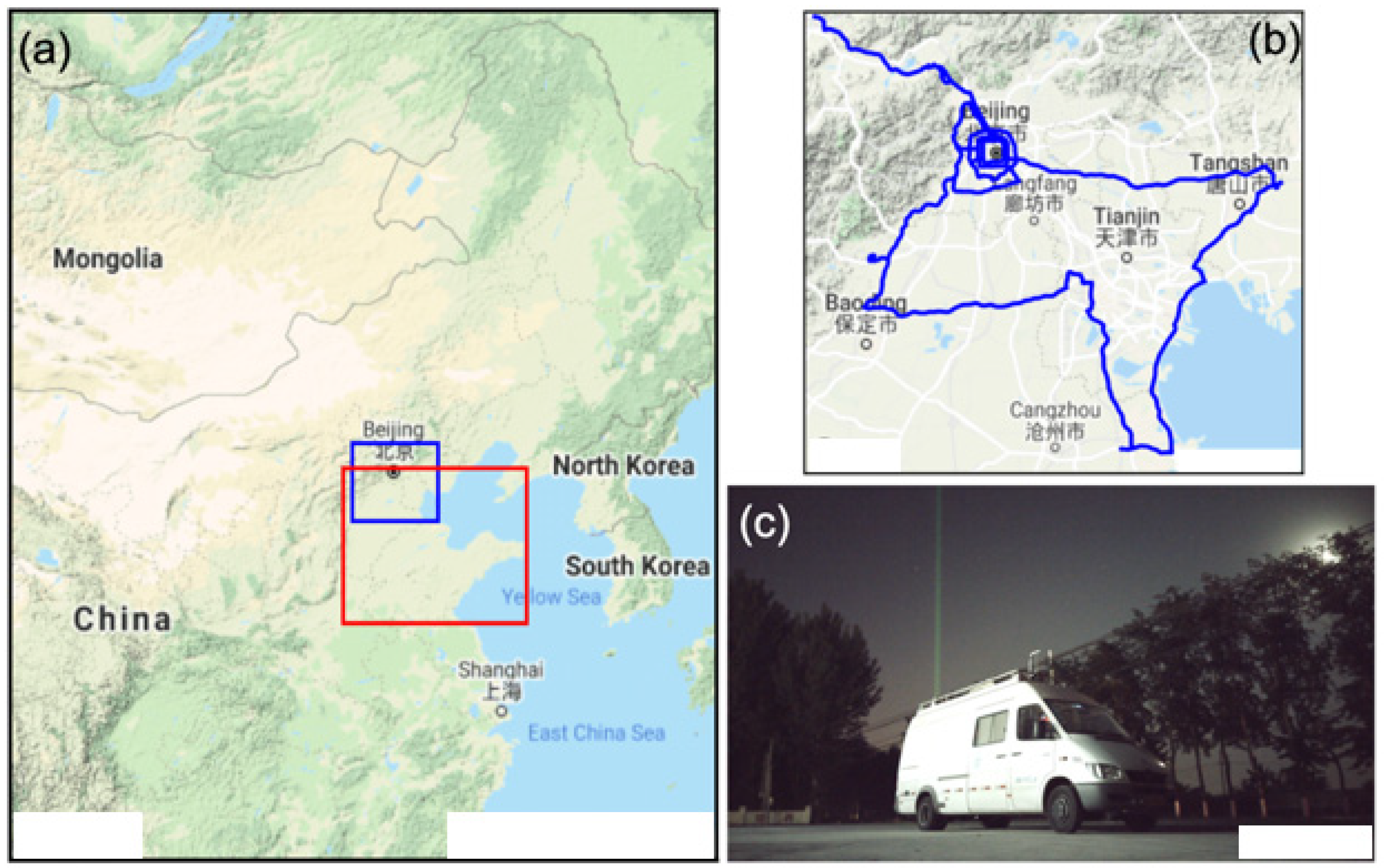


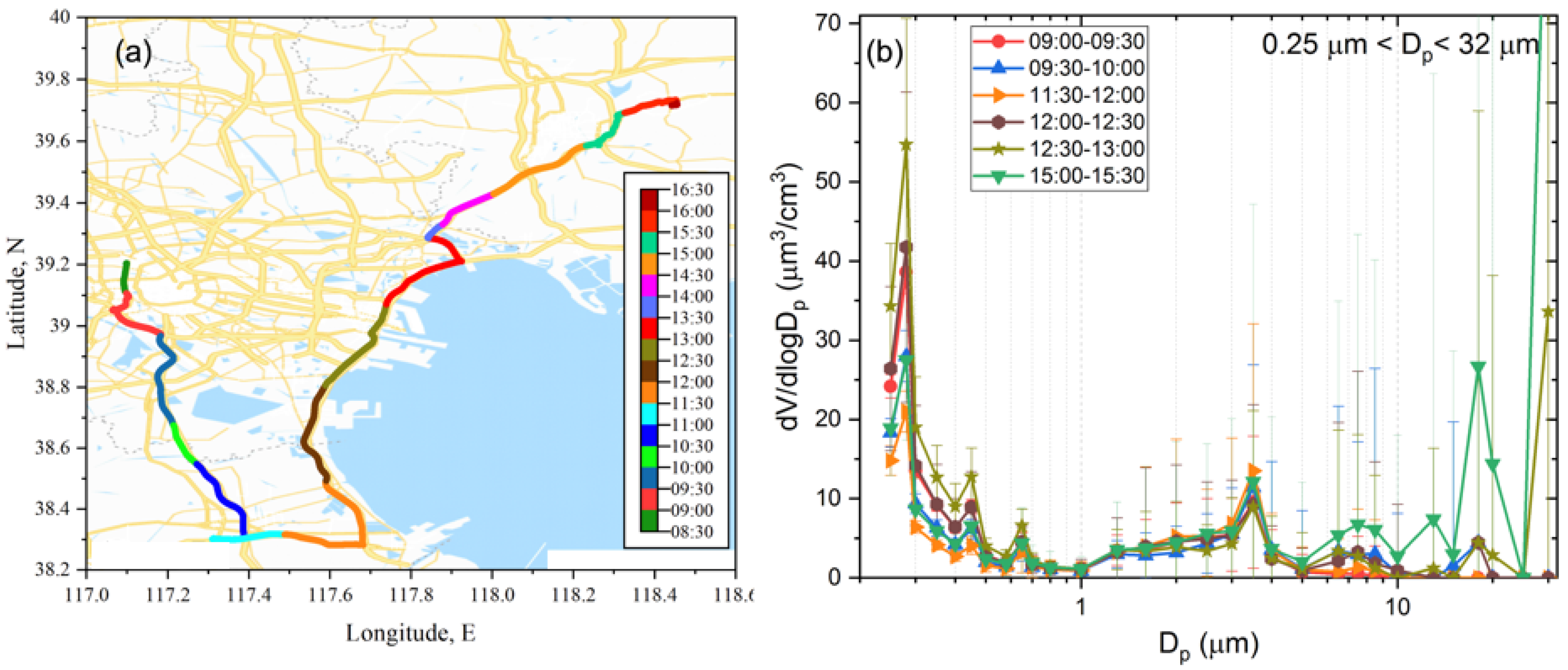
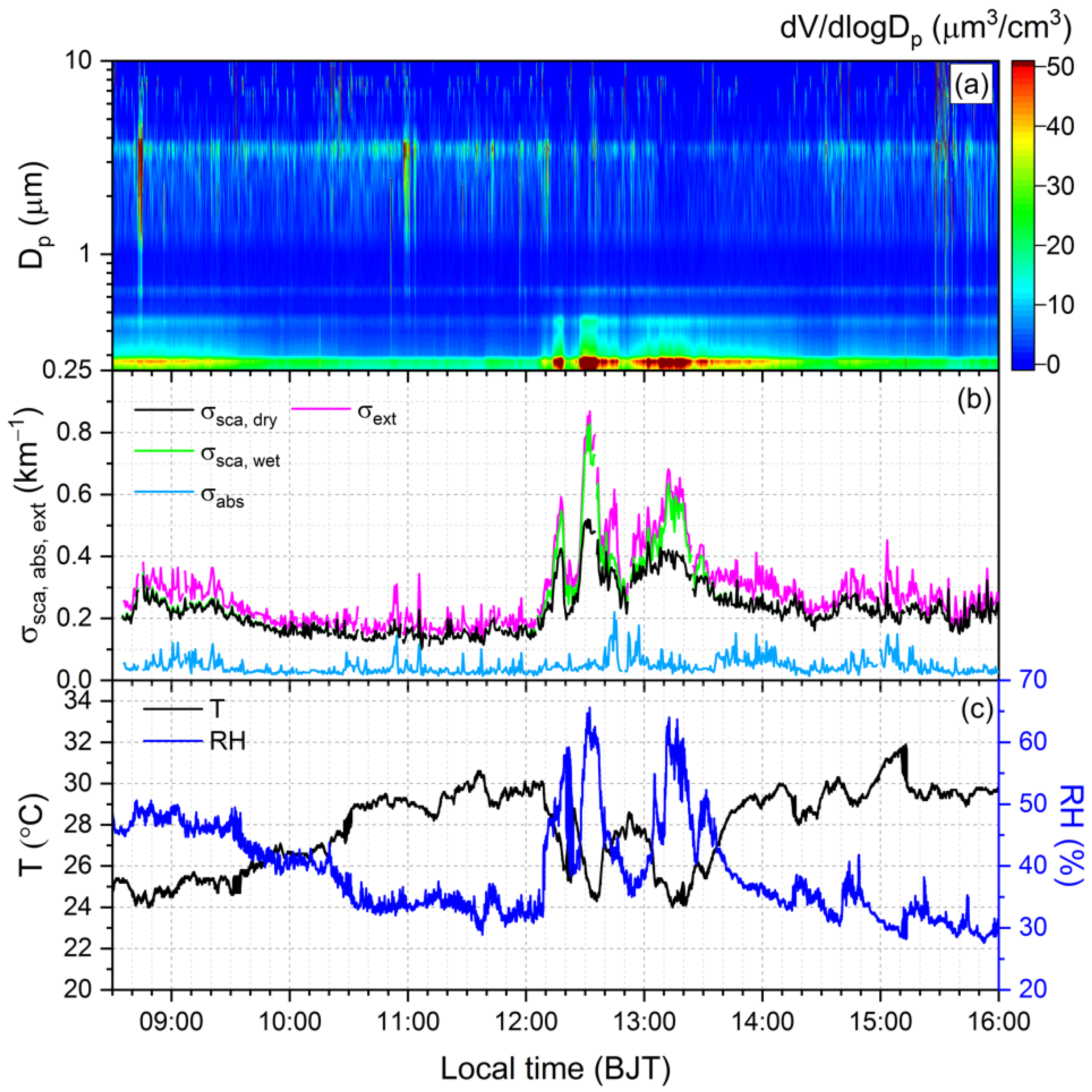

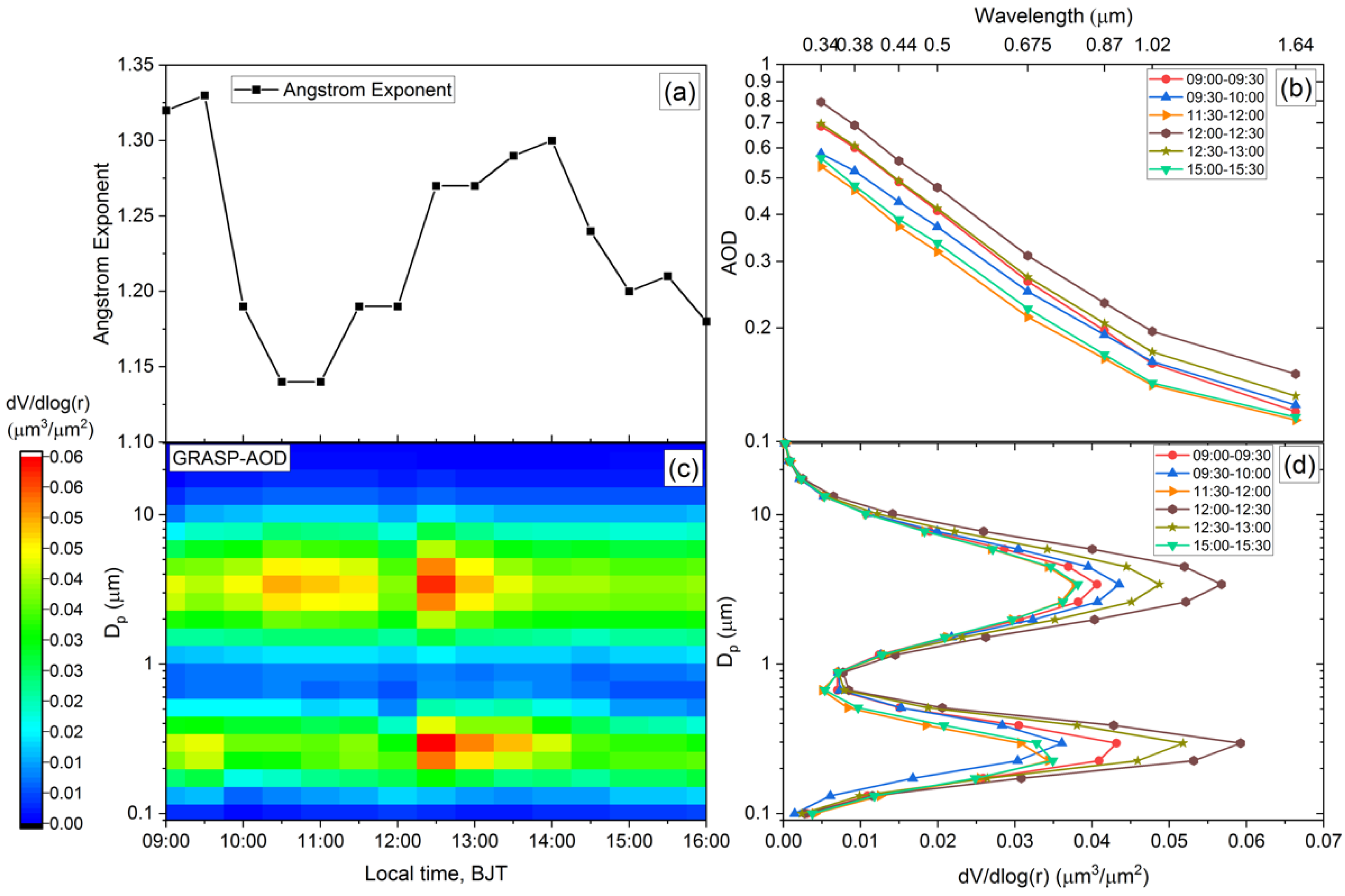
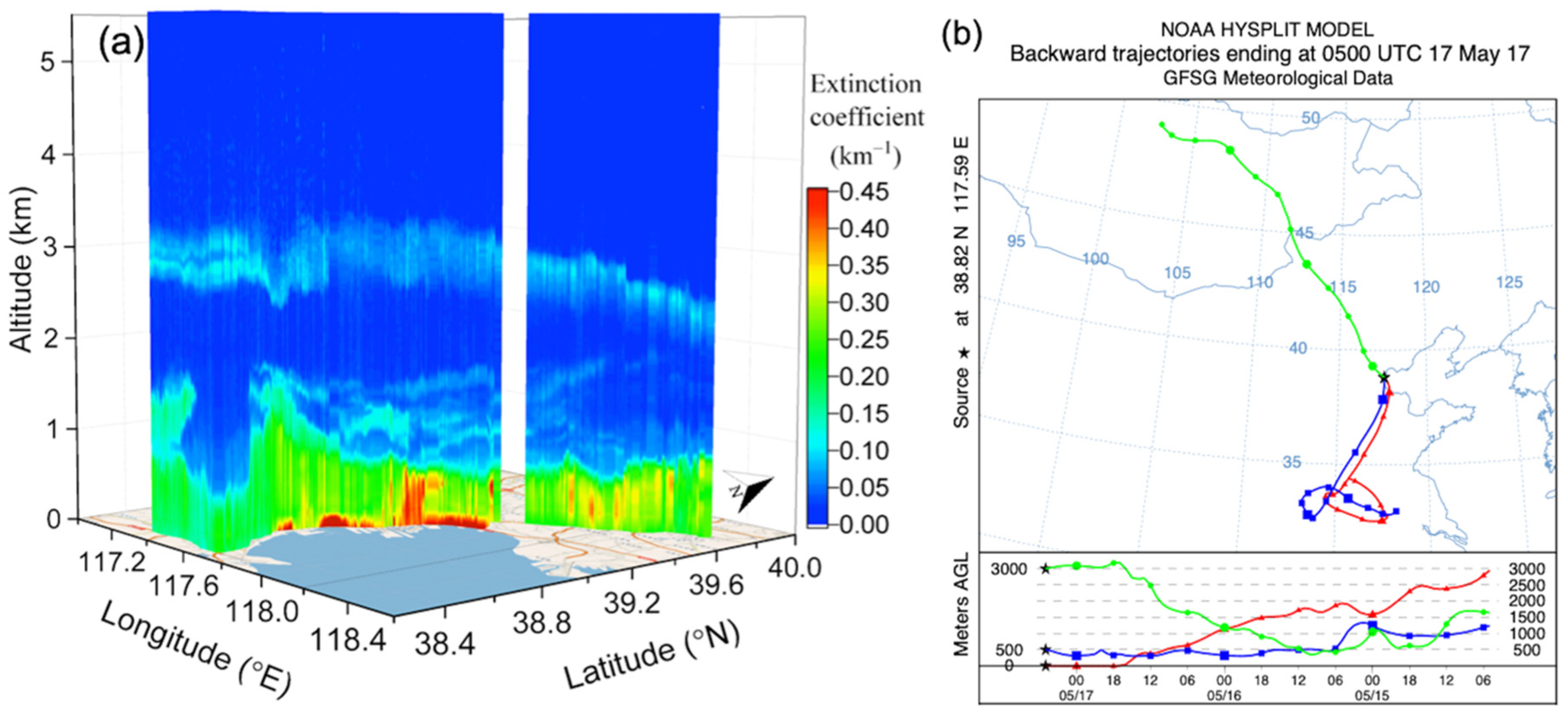
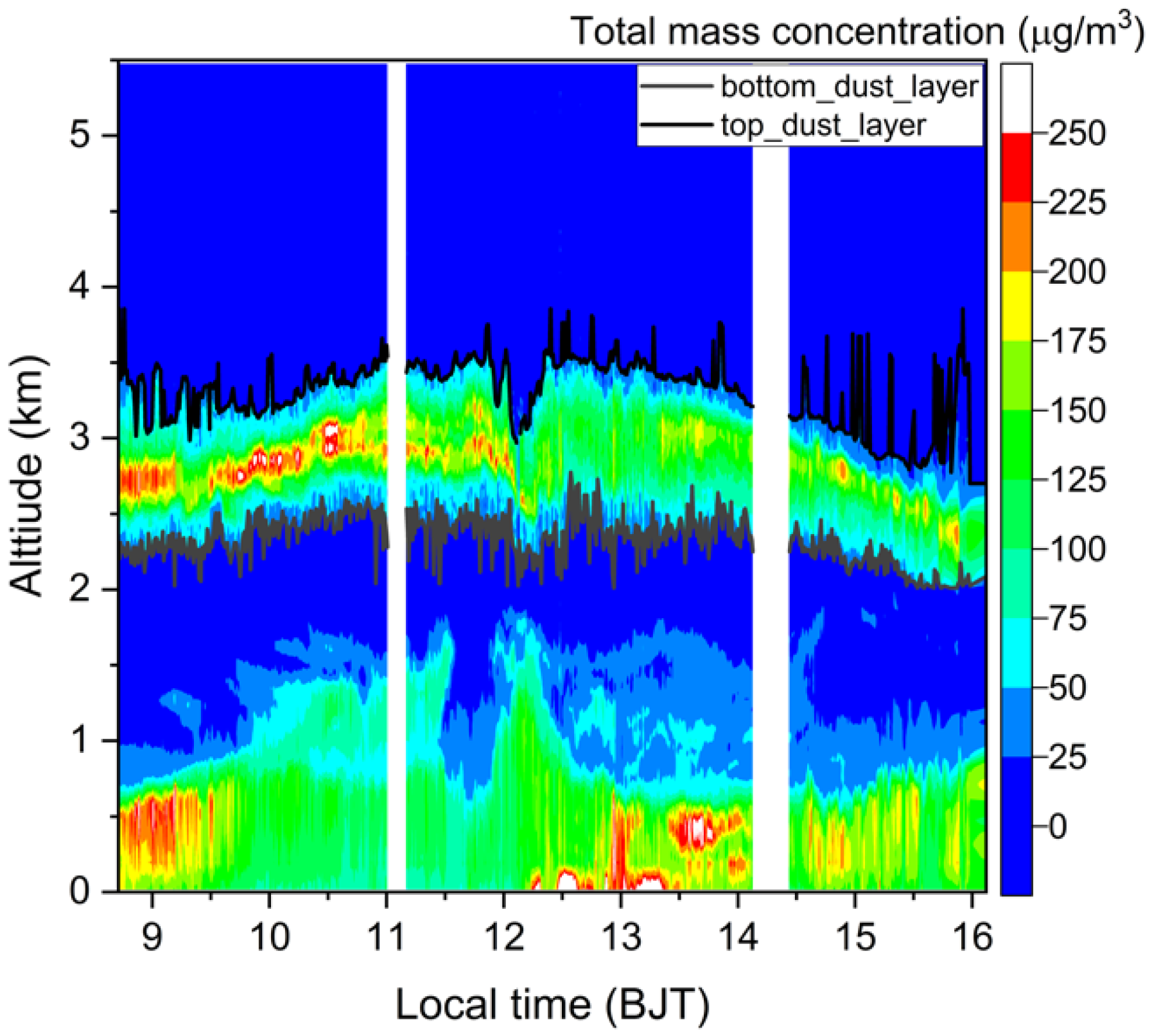
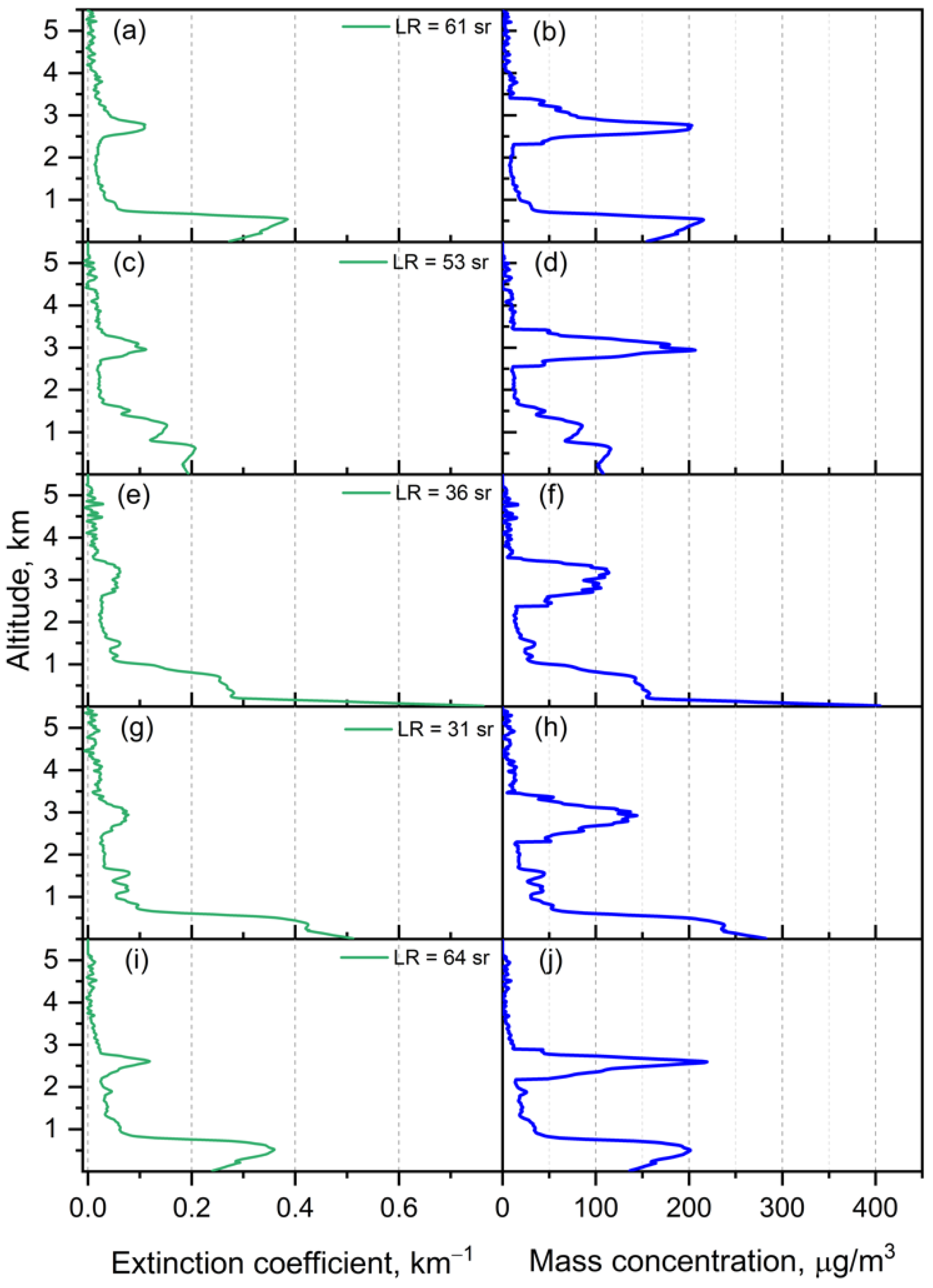

| Instrument | Make and Model | Wavelength (nm) | Temporal Resolution | Aerosol Physical/Chemical/Optical Properties | Uncertainty |
|---|---|---|---|---|---|
| Micro-pulse LIDAR | CE370, CIMEL | 532 | 30 s | Vertical profile (Attenuated backscatter) (Extinction coefficient Mass concentration) | 15% 25% 35–45% |
| PLASMA Sun Photometer | #650, LOA | 340, 380, 440, 500, 675, 870, 940, 1020, 1640 | 10 s | Column-integrated optical properties (AOD, Angstrom Exponent, Precipitable Water) (Volume Size Distribution) | 2% (VIS/NIR) 3% (UV) 10–20% |
| Nephelometer (3-λ) | Aurora 4000, Ecotech | 450, 525, 635 | 30 s | Scattering coefficient | - |
| Aethalometer (7-λ) | AE33, Maggee Scientific | 370, 470, 520, 590, 660, 880, 950 | 1 s | Absorption coefficient BC concentration | - |
| Optical Particle Counter (0.25–32 μm) | Sky-OPC model 1.129, GRIMM Aerosol Technik | 655 | 6 s | Number concentration Number size distribution PM1, PM2.5, PM10 mass concentration | 5% |
| NO–NO2–NOx analyser | 42i, Thermo Electron | n/a | 10 s | NO–NO2–NOx concentration | 1% |
| SO2 analyser | 43i, Thermo Electron | n/a | 10 s | SO2 concentration | 1% |
| O3 analyser | 49i, Thermo Electron | n/a | 20 s | O3 concentration | 1% |
| Weather station | Airmar | n/a | 1 s | Pressure, temperature, relative humidity, wind speed/direction | - |
| Mobile Transects | Date | AOD (440 nm) (Min–Max) | AE (440–870) (Min–Max) | PBL Height (km) |
|---|---|---|---|---|
| Beijing, 4th ring road | 9 May 2017 | 0.62–0.84 | 0.67–0.93 | 1.7–2.2 |
| Beijing, 5th ring road | 11 May 2017 | 0.24–0.91 | −0.03–1.12 | 1.5–3.6 |
| Beijing, 5th and 6th ring road | 13 May 2017 | 0.08–0.16 | 0.41–1.25 | 1.2–3.9 |
| Beijing–Baoding–Tianjin (AB) | 16 May 2017 | 0.2–0.7 | 0.38–2.32 | 0.3–1.7 |
| Tianjin–Tangshan (BC) | 17 May 2017 | 0.3–0.79 | 1–1.9 | 0.3–1.3 |
| Tangshan–Beijing (CA) | 18 May 2017 | 0.43–1.34 | 1.22–1.74 | 1–1.6 |
| Beijing, 5th ring road | 19 May 2017 | 1.47–1.9 | 1.21–1.51 | 0.5–1 |
| Time Interval | Mass Concentration (μg m−3) | ||
|---|---|---|---|
| 08:40–09:00 | 0.14 ± 0.15 | 66 ± 10 | 80 ± 85 |
| 09:00–09:30 | 0.15 ± 0.15 | 59 ± 17 | 85 ± 82 |
| 09:30–10:00 | 0.13 ± 0.10 | 56 ± 10 | 75 ± 57 |
| 10:00–10:30 | 0.14 ± 0.07 | 52 ± 12 | 80 ± 41 |
| 10:30–11:00 | 0.13 ± 0.06 | 50 ± 11 | 74 ± 34 |
| 11:00–11:30 | 0.14 ± 0.06 | 43 ± 14 | 78 ± 33 |
| 11:30–12:00 | 0.1 ± 0.06 | 46 ± 14 | 57 ± 34 |
| 12:00–12:30 | 0.18 ± 0.09 | 40 ± 13 | 100 ± 50 |
| 12:30–13:00 | 0.16 ± 0.13 | 35 ± 12 | 88 ± 72 |
| 13:00–13:30 | 0.15 ± 0.13 | 39 ± 11 | 83 ± 71 |
| 13:30–14:00 | 0.15 ± 0.13 | 45 ± 11 | 87 ± 74 |
| 14:00–14:30 | 0.13 ± 0.11 | 42 ± 8 | 73 ± 60 |
| 14:30–15:00 | 0.13 ± 0.12 | 52 ± 12 | 71 ± 65 |
| 15:00–15:30 | 0.13 ± 0.12 | 47 ± 11 | 75 ± 66 |
| 15:30–16:00 | 0.13 ± 0.11 | 57 ± 14 | 71 ± 59 |
| mean | 0.13 | 1.66 | 0.43 | 0.68 | 0.8 | 1.75 | 1.5 | 0.01 |
| std | 0.01 | 0.03 | 0.01 | 0.03 | 0.1 | 0.34 | 0.05 | 0.005 |
| impact on mass (PBL) | 7% | 0.5% | 0.7% | 0.6% | 4% | 20% | 13% | 1% |
| impact on mass (dust) | - | 2% | - | 3% | - | 20% | 1% | 0.1% |
Publisher’s Note: MDPI stays neutral with regard to jurisdictional claims in published maps and institutional affiliations. |
© 2021 by the authors. Licensee MDPI, Basel, Switzerland. This article is an open access article distributed under the terms and conditions of the Creative Commons Attribution (CC BY) license (https://creativecommons.org/licenses/by/4.0/).
Share and Cite
Popovici, I.E.; Deng, Z.; Goloub, P.; Xia, X.; Chen, H.; Blarel, L.; Podvin, T.; Hao, Y.; Chen, H.; Torres, B.; et al. Mobile On-Road Measurements of Aerosol Optical Properties during MOABAI Campaign in the North China Plain. Atmosphere 2022, 13, 21. https://doi.org/10.3390/atmos13010021
Popovici IE, Deng Z, Goloub P, Xia X, Chen H, Blarel L, Podvin T, Hao Y, Chen H, Torres B, et al. Mobile On-Road Measurements of Aerosol Optical Properties during MOABAI Campaign in the North China Plain. Atmosphere. 2022; 13(1):21. https://doi.org/10.3390/atmos13010021
Chicago/Turabian StylePopovici, Ioana Elisabeta, Zhaoze Deng, Philippe Goloub, Xiangao Xia, Hongbin Chen, Luc Blarel, Thierry Podvin, Yitian Hao, Hongyan Chen, Benjamin Torres, and et al. 2022. "Mobile On-Road Measurements of Aerosol Optical Properties during MOABAI Campaign in the North China Plain" Atmosphere 13, no. 1: 21. https://doi.org/10.3390/atmos13010021
APA StylePopovici, I. E., Deng, Z., Goloub, P., Xia, X., Chen, H., Blarel, L., Podvin, T., Hao, Y., Chen, H., Torres, B., Victori, S., & Fan, X. (2022). Mobile On-Road Measurements of Aerosol Optical Properties during MOABAI Campaign in the North China Plain. Atmosphere, 13(1), 21. https://doi.org/10.3390/atmos13010021








